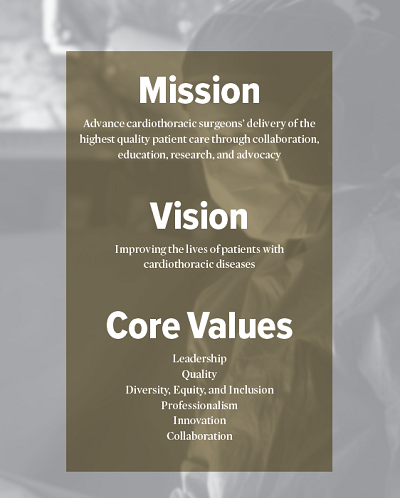STS News, Fall 2020 — “A living document and an ongoing conversation.” That’s how the Society’s new Strategic Plan is described.
The initial brainstorming session for the plan took place last fall, but the real work began in the spring, just as COVID-19 was about to surge in the US. STS President Joseph A. Dearani, MD, led a 2-day strategic planning retreat in early March that included Board members, other surgeon leaders, the staff management team, and an outside consultant.
“When I accepted the position as STS President, I promised to do everything possible to advance the specialty for all members, no matter their discipline, geography, or practice setting,” said Dr. Dearani. “I believe this new strategic plan sets us on the right track to do that.”
The STS Board approved the plan in June, recognizing that the Society has both the capacity and the capability to do things differently and even more successfully than in the past, especially in the areas of member engagement, virtual education, diversity, and advocacy – ultimately making it easier for members “to improve the lives of patients with cardiothoracic diseases.”
Member Engagement, Virtual Education
One priority of the new plan addresses the user experience of members, which has changed considerably due to COVID and will continue to look different in this new era.
Because the investment and framework were already in place, STS quickly was able to expand its online educational opportunities, providing meaningful and targeted information to audiences around the world. The offerings have included interactive webinars and podcasts addressing clinical topics, as well as financial and wellness-related ones.
These early experiences with virtual education are helping the Society identify the key features and technologies that are most successful and engaging so that when STS 2021 is held as a virtual meeting in January, the experience will be unforgettable for all participants – physicians, trainees, allied health, and exhibitors (see cover).
Earlier this summer, the Society launched its new Learning Center (see page 2) through which users can access interactive educational programs and have opportunities to earn CME and other credit anytime, anywhere. Programs include the new robotic surgery online curriculum, Annual Meeting Online, and various other learning modules. Soon to come will be the long awaited STS Cardiothoracic Surgery E-Book (see page 7).
Diversity, Equity, and Inclusion
Another key priority of the strategic plan reaffirms the Society’s commitment to diversity, equity, and inclusion.
“The Board fully recognized the need for the specialty to become much more reflective of the population it serves, which is, of course, especially relevant in this era where there is a strong and understandable push toward addressing racial injustice,” said Dr. Dearani. “We also recognized how important it is to confront racial health disparities and help develop a diverse pipeline of residents coming into the specialty.”
Recently, a special task force on diversity and inclusion was elevated into a workforce, and members of that workforce helped to develop a statement condemning racism and racial inequities in health care.
The new workforce also is developing content for the Vivien Thomas Symposium at STS 2021, the Society’s new podcast series, “Same Surgeon, Different Light,” and a diversity resources page on the STS website (see page 13).

Advocacy
For the first time, advocacy has been listed as a key focus of the strategic plan. This is extremely important in the current environment where COVID has caused financial strain on hospitals and health care systems around the world. In addition, cardiothoracic surgeons in the United States are facing Medicare reimbursement cuts of up to 9% in January (see page 18).
Moving Forward
Although fully immersed in expanding education, diversity, and advocacy initiatives, the Society also remains committed to ensuring that its newly transformed STS National Database and STS Research Center are important parts of members’ day-to-day practices. Just as important is leveraging technologies such as artificial intelligence and machine learning in enhancing the Society's quality improvement initiatives.
“We are going to be even more relevant to our members at a time when they seek community, education, resources, research, and data,” said STS CEO and Executive Director Elaine Weiss. “That's what the legacy of STS is, and that's what its future is.”
She emphasizes that the Society has a responsibility to keep this new plan alive and make sure that it doesn’t become a document that just sits on a shelf.
“Our goal in creating this plan is to ensure that it is not just a list of activities and boxes to check off,” Weiss said. “We have developed detailed goals and objectives with actionable and measurable strategies. We will bring the plan back to the Board on a regular basis and ask, ‘Are we doing it right?’ and ‘Is it still relevant?’.”
To learn more details about the plan and its goals and objectives, visit sts.org/strategicplan.